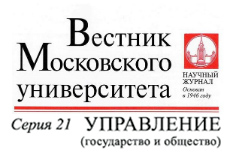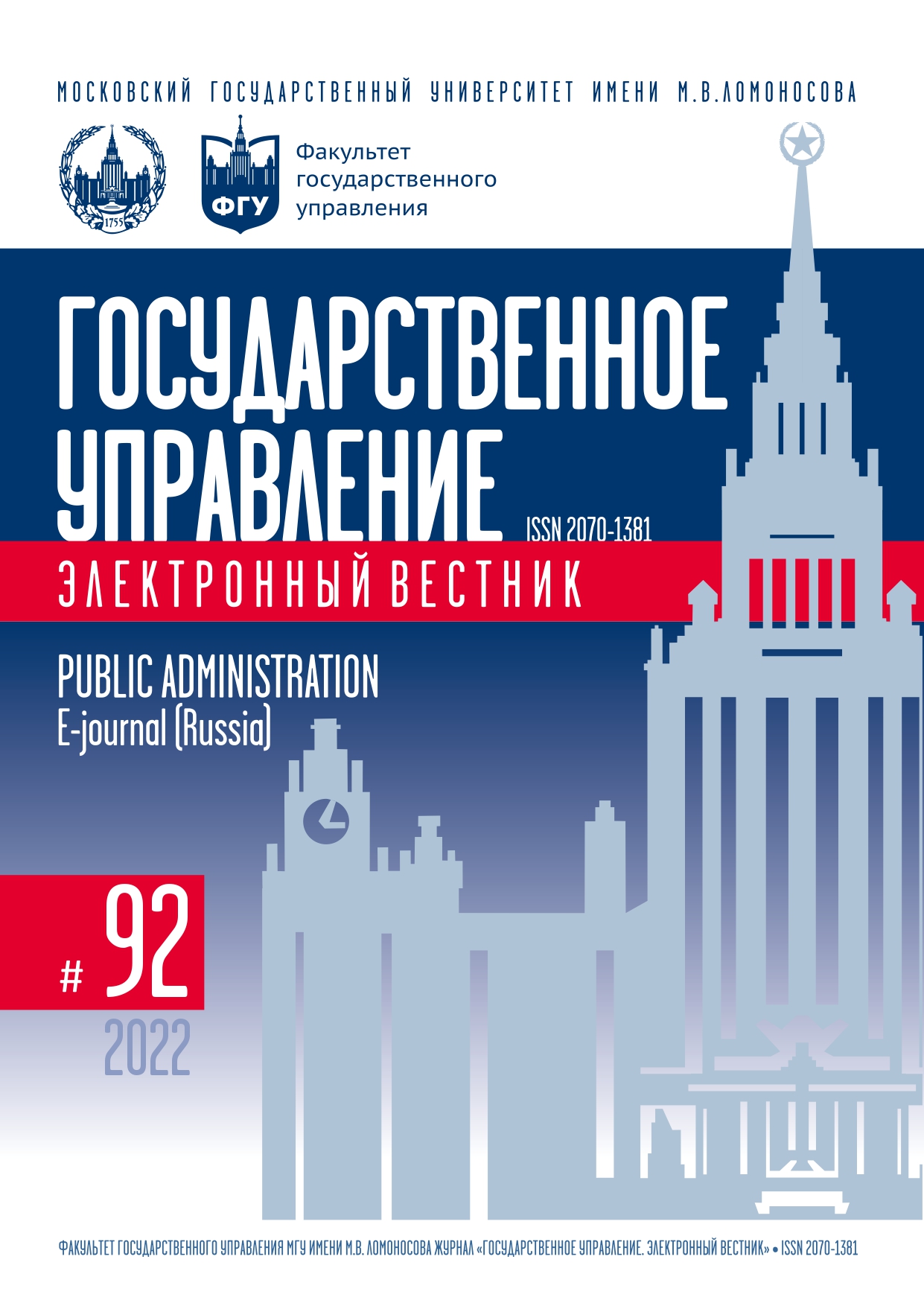Problems and Prospects for the Development of Russian Urban Agglomerations
Keywords:
Regional economy, spatial development, urban agglomerations, infrastructural support, urbanisation, strategic planning of agglomeration processesAbstract
The article is devoted to theoretical study of problems of Russian urban agglomerations development in the context of external and internal socio-economic challenges associated with the COVID-19 pandemic, transformation of the global economic system, infrastructural constraints and demographic features of spatial development of the Russian Federation territories. The article provides a scientometric analysis on the subject of “urban agglomerations” on the basis of publications submitted to the RSCI. The results of the study showed a growing dynamics of publication activity from 2001 to 2021, which indicates a high interest among the scientific community to the issues related to the identification of problems, development and management of urban agglomerations in Russia. Foreign experience in analyzing the problems of agglomeration processes development on the example of Indonesia and China was as well considered. Based on the results of the study of publications by Indonesian and Chinese researchers, the following problems of agglomerations have been identified: adaptation to climate change is not taken into account; there are no practical tools for managing demographic processes in agglomerations due to intensive population growth; the infringement of the rural way of life; uncontrolled development of residential infrastructure around agglomerations. Based on the study of Russian agglomerations, the systemic problems of agglomerations have been identified: the lack of a unified approach to the delimitation of agglomerated spaces, institutionalization of agglomerations as unique urbanized territorial institutions. The consequences of the COVID-19 pandemic in large urban agglomerations in Russia (on the example of Moscow and St. Petersburg) have been assessed. As a result, the prospects for developing agglomerations based on current trends in economic development of the Russian Federation were identified. The following methods were used for the research: comparative analysis, content analysis, correlation and regression analysis, graphical method and systematic approach.
References
Анимица Е.Г., Власова Н.Ю. Проблемы и перспективы развития городских агломераций // Регионалистика. 2020. Т. 7. № 3. С. 60–66. DOI: 10.14530/reg.2020.3.60
Бавина К.В., Лабушкина И.Е. Проблемы законодательного регулирования городских агломераций в России // Вестник экспертного совета. 2019. № 4 (19). С. 60–64.
Бездудная А.Г., Трейман М.Г., Смирнов Р.В. Особенности агломераций и миграции населения в условиях пандемии // Известия Санкт-Петербургского государственного экономического университета. 2021. № 5 (131). С. 93–99.
Волчкова И.В., Шадейко Н.Р., Вотякова И.В., Воробьева Е.С., Уфимцева Е.В. Развитие рынка труда в экономическом пространстве Томской агломерации // Экономика строительства. 2020. № 6 (66). С. 44–54.
Гонтарева Д.Н., Лозовова Л.А. Влияние пандемии на социально-экономическое развитие городов (на примере городов-миллионников Юга России) // Государственное и муниципальное управление. Ученые записки. 2021. № 4. С. 77–85. DOI: 10.22394/2079-1690-2021-1-4-77-85
Зубаревич Н.В. Влияние пандемии на социально-экономическое развитие и бюджеты регионов // Вопросы теоретической экономики. 2021. № 1 (10). С. 48–60. DOI: 10.24411/2587-7666-2021-10104
Кельбах В.С. Транспортная инфраструктура как элемент городской агломерации // Вестник Санкт-Петербургского университета. Серия 7. Геология. География. 2013. № 2. С. 135–144.
Крылов П.М., Митигами М., Семина И.А., Сидоров В.П., Филичкина Д.А. Проблемы и перспективы территориального планирования формирующихся агломераций (на примере концепции развития Махачкалинской агломерации) // Географическая среда и живые системы. 2021. № 1. С. 70–92. DOI: 10.18384/2712-7621-2021-1-70-92
Леонтьева Л.С., Соболев С.А. Участие Московской агломерации в межрегиональном и межмуниципальном сотрудничестве // Вестник Московского университета. Серия 21: Управление (государство и общество). 2021. № 1. С. 3–31.
Лола А.М., Меньшикова Е.П., Лола У.А. Профессиональное городское и агломерационное управление в России: состояние и что делать // Градостроительство. 2011. № 3 (13). С. 56–64.
Маевская Л.И. Точки роста в государственной политике развития страны: основные понятия и тенденции развития // Вестник Института экономики Российской академии наук. 2020. № 6. С. 142–157. DOI: 10.24411/2073-6487-2020-10075
Михайлов А.С., Хвалей Д.В. Приоритеты инновационного развития ведущих приморских агломераций европейской части России // Вестник Балтийского федерального университета им. И. Канта. Серия: Естественные и медицинские науки. 2020. № 4. С. 45–58.
Одинцова А.В. Городские агломерации: объективные основы формирования и проблемы институционализации в России // Вестник Института экономики Российской академии наук. 2021. № 5. С. 57–79. DOI: 10.52180/2073-6487_2021_5_57_79
Петрова Д.В. Современные подходы к организации мониторинга пассажиропотоков общественного транспорта городских агломераций // International Journal of Open Information Technologies. 2020. Т. 8. № 1. С. 47–57.
Фаттахов Р.В., Низамутдинов М.М., Орешников В.В. Анализ и моделирование тенденций развития системы территориального расселения в России // Экономика региона. 2019. Т. 15. № 2. С. 436–450. DOI: 10.17059/2019-2-10
Швалов П.Г. К вопросу о развитии логистической инфраструктуры в межрегиональных городских агломерациях // Логистика — евразийский мост: Материалы XV Международной научно-практической конференции. Красноярск-Енисейск, 27 апреля 2020 года. Красноярск-Енисейск: Красноярский государственный аграрный университет. 2020. С. 211–215.
Chuanglin F., Danlin Y. China’s Urban Agglomerations. Beijing: Science Press, 2020.
Lei L., Shaojun M., Yilin Zh., Xinyue X. Integrated Regional Development: Comparison of Urban Agglomeration Policies in China // Land Use Policy. 2022. Vol. 114. DOI: 10.1016/j.landusepol.2021.105939
Rahayu H., Haigh R., Amaratunga D. Strategic Challenges in Development Planning for Denpasar City and the Coastal Urban Agglomeration of Sarbagita // Procedia Engineering. 2018. Vol. 212. P. 1347–1354. DOI: 10.1016/j.proeng.2018.01.174
Surya B., Salim A., Hernita H., Suriani S., Menne F., Rasyidi E.S. Land Use Change, Urban Agglomeration, and Urban Sprawl: A Sustainable Development Perspective of Makassar City, Indonesia // Land. 2021. Vol. 10. Is. 6. DOI: 10.3390/land10060556
Downloads
Published
How to Cite
Most read articles by the same author(s)
- Lidia S. Leontieva, Ksenia Yu. Proskurnova, Spatial Planning Levels for Territory Development , Public Administration. E-journal (Russia): No. 94 (2022)
Similar Articles
- Sergey A. Sobolev, Toolkit for Integrated Assessment of Socio-Economic Development Scale of Urban Agglomerations , Public Administration. E-journal (Russia): No. 103 (2024)
- Ksenia Yu. Proskurnova, Issues of Russian Regions Spatial Development , Public Administration. E-journal (Russia): No. 92 (2022)
- Olga V. Grushina, Vladimir A. Rusanovsky, Managing Agglomeration Processes in the Development of Suburbanized Territories: A Case of Irkutsk Region , Public Administration. E-journal (Russia): No. 97 (2023)
- Ludmila K. Matveeva, Ilya I. Nikiforov, Some Results of Far Eastern Federal District Social and Economic Development in 2012–2020 , Public Administration. E-journal (Russia): No. 87 (2021)
- Maria S. Varenik, Impact of Research and Innovative Activity on Russian Regions’ GRP: Correlation and Regression Analysis , Public Administration. E-journal (Russia): No. 107 (2024)
- Anna A. Voloshinskaya, Varvara V. Akimova, City’s Sustainable Development and Indicators for Its Measurement , Public Administration. E-journal (Russia): No. 93 (2022)
- Vladimir I. Shmakov, Main Directions of Modern Transformation and Modernization of Russian Society, Ways to Overcome the Systemic Crisis in the Context of Technological Revolution: Alternative Strategic Development Models , Public Administration. E-journal (Russia): No. 105 (2024)
- Matvey S. Oborin, Mechanisms for Stimulating Innovative Development of Single-Industry Towns in Arctic Territories , Public Administration. E-journal (Russia): No. 91 (2022)
- Elena A. Rossoshanskaya, Tatyana A. Doroshenko, Natalia A. Samsonova, Elena L. Li, Michael E. Kuznetsov, Elena Yu. Ageshina, Agent-Based Demographic Model of the Far East as a Tool to Support Management Decision Making , Public Administration. E-journal (Russia): No. 94 (2022)
- Lydia S. Leontieva, Svetlana V. Avilkina, The Higher Education System as a Strategic Resource for Regional Development , Public Administration. E-journal (Russia): No. 86 (2021)
You may also start an advanced similarity search for this article.




